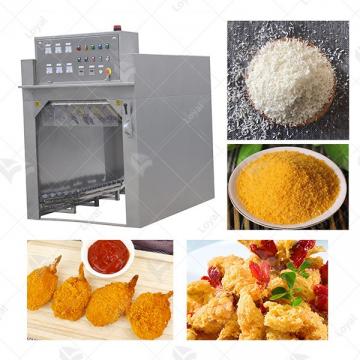
- Shandong Loyal Industrial Co.,Ltd.
- Macaroni Production Machine Instant Noodle Machine Biscuit Making Machine
Home> Processing> Fish Feed Processing Line

Fish Feed Processing Line
2023-05-31 10:08:50Fish feed processing line is a set of mechanical equipment designed for producing high-quality fish feed. The line usually consists of several stages, including raw material preparation, mixing, extrusion, drying and cooling. The raw materials used in fish feed processing include fish meal, soybean meal, wheat flour, corn flour and other ingredients. The mixing stage ensures that the ingredients are thoroughly mixed to form a homogeneous mixture, while the extrusion stage molds the mixture into the desired size and shape. The drying and cooling stages help reduce the moisture content of the final product and extend its shelf life. A complete fish feed processing production line can be used to produce various types of fish feed pellets, such as buoyant, sinking, slow-sinking pellets.

The Flow Chart Of Fish Feed Process Line
- Mixer --- 2. Scre Conveyor --- 3. Twin Screw Extruder --- 4. Air Conveyor --- 5. Muliti-Layer Oven --- 6. Hoister --- 7. Flavoring Line --- 8. Cooling Conveyor --- 9. Packaging

The Function Of Fish Feed Process Line
- Ingredient Preparation: The first step is to gather and prepare the various ingredients needed to make the fish feed. These typically include fishmeal, soybean meal, corn, wheat, and other grains and supplements.
- Mixing: The next step is to mix the ingredients together in the correct proportions. This is usually done in a large mixer or blender that ensures the ingredients are evenly distributed.
- Extrusion: Once the ingredients are mixed, the mixture is fed into an extruder. The extruder is a machine that uses heat and pressure to cook and shape the mixture into pellets of the desired size and shape.
- Drying: The pellets are then dried to remove excess moisture and improve their shelf life. This is typically done using a dryer or oven.
- Packaging: The final step is to package the fish feed into bags or other containers. The packaging is usually done automatically using a bagging machine or other packaging equipment.

The Parameter Of Fish Feed Process Line
|
Model |
Installed Powder (kw) |
Powder Consumption (kw) |
Output (kg/h) |
Size(L*W*H) (mm) |
|
LY65 |
70kw |
45kw |
120-150kg/h |
20000*1200*2200mm |
|
LY70 |
105kw |
85kw |
200-250kg/h |
22000*1500*2200mm |
|
LY85 |
160kw |
130kw |
300-500kg/h |
25000*2500*2300mm |
|
LY95 |
220kw |
154kw |
800-1000kg/h |
28000*2500*3500mm |

The Advantage Of Fish Feed Process Line
|
Controlled Production |
The fish feed processing line ensures that the production process is controlled, and the quality and quantity of feed produced each time are consistent. |
|
Increased Efficiency |
Using processing lines saves time and money by automating the production process, reducing labor and production costs over time. |
|
Multi-Faceted Production |
A fish feed processing production line can produce various types of fish feed pellets such as buoyant, sinking, and slow-sinking pellets to meet the nutritional needs of different fish species. |
|
Improve Feed Quality |
The use of fish feed processing lines ensures that the raw materials are fully mixed, the quality of the extruded pellets is consistent, and the risk of under-feeding or over-feeding of fish is reduced. |
|
Improve Digestibility |
The granulation process improves the digestibility of feed, making it easier for fish to digest and absorb nutrients. |
|
Longer Shelf Life |
The drying and cooling stages in the process increase the shelf life of the final product, reducing spoilage and waste. |
Overall, using a fish feed processing line is an efficient and effective way of producing high-quality fish feed, thereby increasing the profitability of the fish farming industry.


Fish Feed Products Display
Fish feed refers to food specially formulated to meet the nutritional needs of fish in aquaculture. Feeds should contain the proper balance of protein, carbohydrates, fats, vitamins, minerals and other essential components important for the growth, health and reproduction of fish.
There are several types of fish feed products on the market, including:
|
Flake Feed |
This is the most commonly used fish feed in aquariums and small fish farms. It is usually made by mixing different ingredients before drying and cutting into small slices. |
|
Pellet Feed |
Pellet feed is the most commonly used fish feed in intensive farming. It is usually manufactured using fish feed processing lines to ensure consistent quality and particle size. |
|
Crumble |
This feed is similar to pellet feed, but the pellets are broken into smaller pieces for smaller fish species. |
|
Wafers |
This type of feed is designed to sink and is mainly used for bottom fish. |
|
Freeze-Dried Food |
This type of fish feed contains all the nutritional value of frozen food, but is dried and packaged for a longer shelf life. |
|
Live Feed |
Live feed consists of small insects and tiny crustaceans used to feed larvae and larvae. |

 Commercial Japanese Panko Bread Crumb Grinder Machine
Commercial Japanese Panko Bread Crumb Grinder Machine Japanese Bread Crumbs Processing Line
Japanese Bread Crumbs Processing Line Automatic Cookies Making Machines
Automatic Cookies Making Machines Fully Automatic Biscuit Making Machines
Fully Automatic Biscuit Making Machines